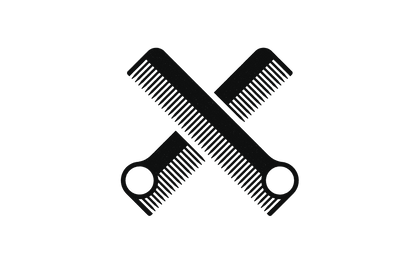Your Cart is Empty
Sometimes customers ask about the differences between combs that are "cut" from a solid piece of material (saw-cut or laser-cut) versus combs made using a molding process. Is one better for your hair than another?
Before talking about combs, the first thing to consider is: what is hair? Many people think of hair as being extremely delicate. In fact, human hair is made of keratin, the same material your fingernails are made of. By weight, it's stronger than aluminum, and is almost as strong as steel. In fact, all the hairs on one person's head could hold the weight of two elephants. Hair is often a "harder" material than what a comb itself is made of.
There are many things which can damage your hair, but they primarily occur on the level of chemistry, when the keratin structure of the hair has been weakened: excess sunlight, coloring, over-washing, and over-drying the hair. Those are the things to avoid in order to maintain healthy, beautiful hair. Of course, you also want to avoid combs with sharp tips or edges, and combs which tug on your hair, but that's largely a matter of comfort.
The vast majority of combs in the world, probably over 95%, are made using molding technology. The material starts out in liquid form, enters the mold, then as it solidifies the mold opens to release the comb (it's not made from sticking two parts together). A faint line is visible on these combs where the mold opens to release the comb. If a high quality, well-maintained mold is used, these lines should be very minimal. The remaining 5% of combs on the market are cut from a solid object (wood, metal, horn, or plastics like acetate). "Cut" combs have lines/grooves inside between the teeth from the saws or laser cutting process.
Perhaps the most important step in making a great comb comes after it's been "cut" or molded. A good quality comb must be correctly "finished" -- using various polishing processes -- to remove burrs, excess flashing, and other excess material that arises from the cutting or molding process. This hand-finishing work is absolutely critical.
One of our competitors, Kent, who make saw-cut acetate combs, consider the cutting marks inside the tines to be a virtue. Their packaging says: "Another unique feature is that the inside edge of each tooth is left with the rough saw-cut impression... which cleans the hair of dust and encourages the release of natural hair oils."
On the other hand, some people claim that the seams / lines / grooves between the tines can damage hair. But that's actually an urban myth, not based on science or research.
One aspect to consider is that from the first use of the comb, the inside of the tines (teeth) begins to be coated in your natural hair oil and/or hair products, a process which covers over any minor lines or grooves. But even if this weren't the case, human hair isn't remotely fragile enough to be damaged by the normal use of a comb. That's why, even though virtually every comb in the world has minor lines / seams / grooves inside the teeth, there isn't some epidemic of people walking around with comb-damaged hair.
The bottom line: find a comb that's comfortable to use and avoid things which can weaken the chemical structure of your hair (over-washing, too much sun, etc.). Those are the keys to having a great head of hair.
Before talking about combs, the first thing to consider is: what is hair? Many people think of hair as being extremely delicate. In fact, human hair is made of keratin, the same material your fingernails are made of. By weight, it's stronger than aluminum, and is almost as strong as steel. In fact, all the hairs on one person's head could hold the weight of two elephants. Hair is often a "harder" material than what a comb itself is made of.
There are many things which can damage your hair, but they primarily occur on the level of chemistry, when the keratin structure of the hair has been weakened: excess sunlight, coloring, over-washing, and over-drying the hair. Those are the things to avoid in order to maintain healthy, beautiful hair. Of course, you also want to avoid combs with sharp tips or edges, and combs which tug on your hair, but that's largely a matter of comfort.
The vast majority of combs in the world, probably over 95%, are made using molding technology. The material starts out in liquid form, enters the mold, then as it solidifies the mold opens to release the comb (it's not made from sticking two parts together). A faint line is visible on these combs where the mold opens to release the comb. If a high quality, well-maintained mold is used, these lines should be very minimal. The remaining 5% of combs on the market are cut from a solid object (wood, metal, horn, or plastics like acetate). "Cut" combs have lines/grooves inside between the teeth from the saws or laser cutting process.
Perhaps the most important step in making a great comb comes after it's been "cut" or molded. A good quality comb must be correctly "finished" -- using various polishing processes -- to remove burrs, excess flashing, and other excess material that arises from the cutting or molding process. This hand-finishing work is absolutely critical.
One of our competitors, Kent, who make saw-cut acetate combs, consider the cutting marks inside the tines to be a virtue. Their packaging says: "Another unique feature is that the inside edge of each tooth is left with the rough saw-cut impression... which cleans the hair of dust and encourages the release of natural hair oils."
On the other hand, some people claim that the seams / lines / grooves between the tines can damage hair. But that's actually an urban myth, not based on science or research.
One aspect to consider is that from the first use of the comb, the inside of the tines (teeth) begins to be coated in your natural hair oil and/or hair products, a process which covers over any minor lines or grooves. But even if this weren't the case, human hair isn't remotely fragile enough to be damaged by the normal use of a comb. That's why, even though virtually every comb in the world has minor lines / seams / grooves inside the teeth, there isn't some epidemic of people walking around with comb-damaged hair.
The bottom line: find a comb that's comfortable to use and avoid things which can weaken the chemical structure of your hair (over-washing, too much sun, etc.). Those are the keys to having a great head of hair.

